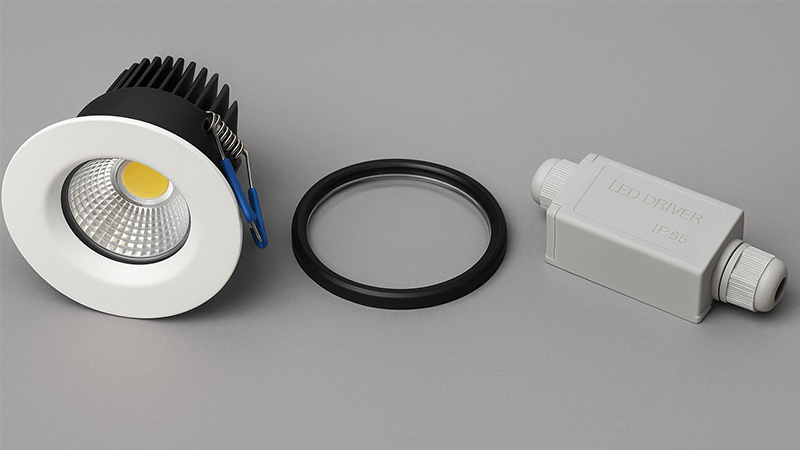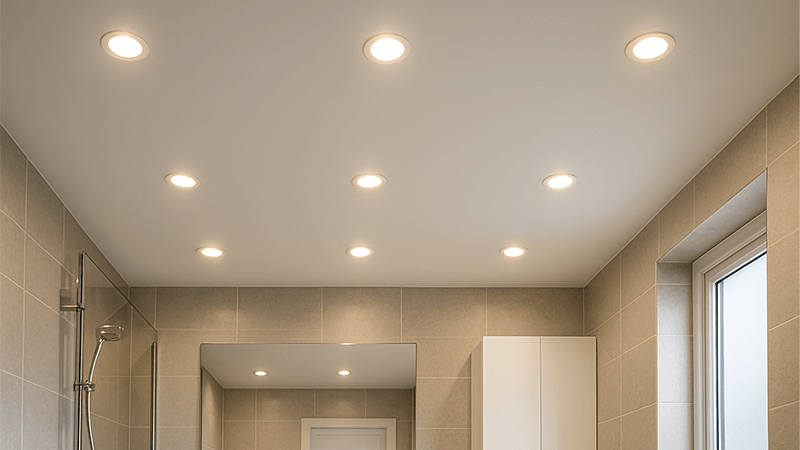Choosing bathroom lights is stressful. Water and electricity don’t mix, and a wrong choice is a serious safety risk. This guide will show you how to pick safe, reliable downlights.
To safely light a bathroom, you must use downlights with an appropriate IP (Ingress Protection) rating for the specific bathroom zone. For areas directly exposed to water, like inside a shower, you need a high rating like IP65. Safety is the most important factor.

I remember a client, a hotel developer, who almost installed standard downlights throughout his new hotel’s bathrooms. He loved the design, but he didn’t realize the danger. I explained that steam and moisture would cause them to fail quickly, or worse, create a serious fire hazard. We switched to the correct IP-rated lights, and he avoided a costly and dangerous mistake. The most important lesson in lighting is that safety always comes first, especially in a challenging environment like a bathroom. Everything from the materials to the electrical components must be chosen to handle moisture and heat. Now, let’s explore what makes a downlight truly suitable for this unique space.
What downlights are suitable for bathrooms?
Sourcing suitable bathroom downlights is tough with so many options. Choosing the wrong one leads to client complaints and replacements. I will show you the exact features of a suitable light.
Suitable bathroom downlights have high moisture resistance, indicated by their IP rating. They should also provide good brightness, accurate color rendering (CRI > 80), and be made from anti-corrosive materials. Safety and durability are the top priorities for this environment.

When I help a purchasing manager like Shaz source lights for a project, we don’t just talk about IP ratings. We talk about long-term performance. A "suitable" downlight is one that is safe, reliable, and looks good for years. The bathroom is a harsh place for any fixture. Constant changes in temperature and humidity attack every component. This is why material choice is so important.
Material Durability
I always recommend downlights made from materials that resist corrosion. Aluminum is a great choice because it’s lightweight and dissipates heat well. But it must be properly treated. Powder-coated or anodized aluminum will resist rust much better than raw aluminum. For extreme coastal environments with salty air, I sometimes even suggest high-grade plastics or stainless steel bezels, as they offer superior corrosion resistance. The lens or diffuser material matters too. A glass lens is easy to clean and won’t yellow over time, but a high-quality polycarbonate (PC) diffuser can offer better impact resistance and a softer light distribution.
Lighting Performance
Beyond materials, the light itself must perform. A bathroom is a functional space. People do their makeup, shave, and get ready for the day. This requires good lighting.
Here is a breakdown of what to look for:
| Feature |
Recommendation |
Why It Matters |
| Brightness |
500-800 lumens per fixture |
Ensures the space is bright enough for tasks like shaving. |
| Color Temp |
3000K (Warm White) or 4000K (Neutral White) |
3000K for a relaxing feel, 4000K for a clean, modern look. |
| Color Rendering |
CRI > 80 (CRI > 90 is ideal) |
Renders skin tones and colors accurately, which is very important. |
A suitable downlight combines robust, moisture-proof construction with excellent light quality. Never sacrifice one for the other.
Can you use normal downlights in a bathroom?
You see a stylish downlight perfect for your project, but it is not rated for bathrooms. Using it seems like a small risk. But this decision can lead to fixture failure and safety hazards.
No, you cannot use normal, non-IP-rated downlights in most parts of a bathroom. These fixtures lack the necessary protection against moisture and steam ingress. Using them poses a significant risk of short circuits, electric shock, and fire, and they will likely fail very quickly.

The difference between a standard downlight and a bathroom-rated one is all about construction. I once took apart a standard downlight and an IP65 downlight side-by-side to show a new client the difference. The standard one had visible gaps around the bezel and at the back where the cable enters. It was designed for a dry, clean living room. On the other hand, the IP65 downlight was clearly built for battle. It had silicone gaskets sealing the lens to the housing. The point where the cable entered was sealed with a waterproof compression gland. Every potential entry point for water was blocked.
The Dangers of Steam and Condensation
The biggest enemy in a bathroom isn’t just direct splashes of water; it’s the steam. When you take a hot shower, the air fills with warm, moist vapor. This vapor can get inside a standard downlight. As the fixture cools down after being turned off, this vapor condenses into liquid water directly onto the circuit boards, wiring, and the LED chip itself. This is a recipe for disaster. The first sign of trouble is often flickering lights. Soon after, the driver can short-circuit, causing the light to fail completely. In the worst-case scenario, this short circuit can overheat and start a fire in the ceiling void. It’s a risk that is never worth taking.
Warranty and Certification Violations
Using a non-IP-rated downlight in a bathroom also voids its warranty. If it fails, the manufacturer is not obligated to replace it because it was used improperly. More importantly, it violates electrical safety codes in almost every country. If an electrical fire were to occur and the investigation found that non-compliant fixtures were installed, the liability would fall on the installer, contractor, and specifier. For a purchasing manager, specifying the wrong product can have huge financial and legal consequences. That’s why I always tell my partners: for bathrooms, only source downlights that explicitly state they are suitable for wet locations and have the test reports to prove their IP rating.
Do I need IP44 or IP65 for a bathroom?
You know you need an IP-rated downlight, but which rating is correct? Choosing a rating that is too low is unsafe, while choosing one that is too high might be unnecessarily expensive.
The IP rating you need depends on the bathroom "zone." IP65 is required for areas inside the shower or bath (Zone 1). IP44 is sufficient for areas just outside the shower and above the sink (Zone 2). Areas far from water may not require a rating (Zone 3).

Understanding bathroom zones is the key to specifying the right IP rating. Think of the bathroom as being divided into different zones based on how likely they are to get wet. Electrical regulations define these zones to ensure safety. While the exact definitions can vary slightly by country, the principles are universal. I always advise my clients to follow these zone-based guidelines strictly.
Breaking Down the Bathroom Zones
Let’s make this simple. I explain it to my clients with this clear structure:
-
Zone 0: This is inside the bathtub or shower basin itself. Any light here must be low-voltage (max 12V) and be totally immersion-proof, so rated at least IP67. It’s rare to place downlights here.
-
Zone 1: This is the area directly above the bath or shower, up to a height of 2.25 meters from the floor. This area gets hit with a lot of water splashes. You absolutely must use a downlight rated at least IP65 here. The ‘6’ means it’s dust-tight, and the ‘5’ means it’s protected against jets of water from any direction. This is non-negotiable for safety.
-
Zone 2: This is the area stretching 0.6 meters (about 2 feet) outside the perimeter of the bath or shower, and also to a height of 2.25 meters from the floor. It also includes the area around the sink. In this zone, lights need to be protected from water spray, so a rating of IP44 is the minimum requirement. The ‘4’ for solids isn’t as critical, but the second ‘4’ for liquids ensures it can handle splashes.
-
Outside Zones (formerly Zone 3): This refers to any area outside of Zones 0, 1, and 2. Here, there is no specific IP rating requirement. However, because a bathroom is a generally humid environment, I always recommend using at least IP20 (standard) downlights that are enclosed. Personally, I advise clients to just use IP44 throughout the entire ceiling for consistency and an extra layer of safety. The cost difference is often small, but the peace of mind is significant. It simplifies purchasing and eliminates any risk of an installer putting the wrong light in the wrong zone.
What type of light is best for a bathroom ceiling?
You need to choose the main ceiling light for a bathroom project. You want something that provides great light, is safe, and looks modern and clean. What’s the best overall choice?
LED downlights are the best type of light for most bathroom ceilings. They are energy-efficient, long-lasting, and available with the necessary IP ratings for safety. They provide excellent, uniform light and have a clean, modern look that fits well in any bathroom design.

When I started in this industry, halogen downlights were popular. They produced a nice warm light, but they had major problems. They got incredibly hot, which was a fire risk in a ceiling with insulation. They also used a lot of energy and burned out quickly. The arrival of high-quality LED lighting completely changed the game, especially for bathrooms. Today, I almost exclusively recommend LED downlights to my clients for bathroom projects, and here’s why.
Why LEDs Are the Clear Winner
LED technology has several key advantages that make it perfect for the bathroom environment.
First, safety and efficiency. LEDs run much cooler than halogen bulbs, drastically reducing the fire risk. They also consume up to 80% less energy, which saves money on electricity bills—a great selling point for any project.
Second, longevity. A good quality LED downlight can last for 30,000 to 50,000 hours. This means no more changing bulbs for 10-15 years in a typical home. For a hotel or commercial project, this massively reduces maintenance costs and labor.
Third, design flexibility. LEDs are compact. This allows for very slim, minimalist downlight designs that sit flush with the ceiling, creating a clean and spacious look. You can get them in various trim colors, color temperatures, and even with smart controls for dimming.
Planning Your Bathroom Lighting Layout
The best approach for a bathroom ceiling is a layered lighting plan using multiple LED downlights. A single, central ceiling light often creates shadows. Using several downlights allows you to create an even, shadow-free layer of ambient light across the entire room.
Here’s a simple strategy I recommend:
| Lighting Layer |
Purpose |
Fixture Type & Placement |
| Ambient |
General illumination for the whole room. |
4-6 IP-rated LED downlights, spaced evenly across the ceiling. |
| Task |
Focused light for grooming at the mirror. |
Wall sconces on either side of the mirror or a dedicated downlight above the sink. |
| Accent |
Highlight architectural features (optional). |
A single IP65 downlight aimed at a feature wall or inside the shower. |
By using IP-rated LED downlights as the foundation of your bathroom lighting, you get a solution that is safe, efficient, low-maintenance, and stylish. It is the best all-around choice for modern bathrooms.
Conclusion
To light a bathroom safely, always use downlights with the correct IP rating for each zone. IP65 for wet areas and IP44 for damp areas are essential for safety and durability.